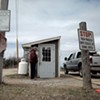Published January 19, 2012 at 5:42 p.m.
Top among Vermonters’ values is this: Ninety-seven percent of residents in the state say the “working landscape” is key to Vermont’s future.
That’s according to questions asked in 2008 and 2009 by the Council on the Future of Vermont, which conducted what they’re calling the most comprehensive survey of Vermonters’ values in the state’s history. More so than any other value, Vermonters could agree on the fact that supporting farm- and forestland is important. Now, champions of the new “Working Lands Enterprise Investment Bill” are parlaying that support into a plan that backers say could revitalize Vermont’s farm and forestry economies.
The bill (known by Statehouse followers as H.496/S.246), is currently being reviewed by the House ag and commerce committes and the Senate ag and economic development committees. When the bill cropped up for a public hearing last night in Montpelier, the mood in the Statehouse meeting room was overwhelmingly supportive.
Groton farmers market manager Mary Berlejung said she’d watched farmland disappear first on Long Island, then in Fairfax County, Va., and didn’t want to see the same thing happen in Vermont. Montpelier resident and well-known writer Tom Slayton called the bill a “bold step” that would protect the working landscape that he called a signature of the state. From Bethel resident Carl Russell came this: “It’s about time.”
So… what’s not to like?
At least one persoon in the audience wasn’t buying it: Leicester resident James Maroney, who spent most of the hearing with his arms folded across his chest, peering coolly at the legislators over the rim of his glasses.
His complaint? For all the bill’s optimism, and for all the vocal support, Maroney — a longtime critic of the conventional (that is, not organic) dairy industry in Vermont — says the working landscapes bill isn’t actually going to fix the state’s broken agricultural economy.
The bill calls for the development of the “Vermont Working Lands Enterprise Fund,” a state-funded investment in small and start-up businesses as well as new services and infrastructure to support the ag and forestry industries. The price tag is $3 million in the first year, with a goal of eventually increasing the state’s investment to $15 million annually.
Additionally the bill would: launch a marketing campaign to draw attention to the natural resources industry in the state; allow towns to designate “working lands enterprise areas” that might qualify for special benefits; and create a new Office of Planning Coordination in the Agency of Administration.
This is all well and good, said Maroney, who told lawmakers he liked the intent of the bill. But he went on to say that in ignoring the question of dairy farming, legislators are having the wrong conversation about ag.
According to the University of Vermont Extension, dairy accounts for somewhere between 70 and 80 percent of ag receipts in Vermont each year — which puts the state first in the country in terms of dependence on a single commodity. Though the number of dairy farms (1021 at the end of 2011) is falling, and the number of small, diversified farms is growing, dairy plays an enormous role in the state’s overall ag economy.
The majority of those dairies are so-called conventional farms — which Maroney says relies on a model of farming developed after World War II to boost yields. That means using nutrient-rich fertilizers (which have been implicated in water pollution in Lake Champlain), and sometimes using artificial hormones to boost milk production. Overproduction is great for consumers: It keeps prices low. But it’s terrible news for farmers, who often have to take less for their milk than it costs to produce it.
Maroney’s objections boil down, in part, to the fact that the working lands bill is silent on the topic of dairy farms, and also doesn’t differentiate between conventional ag and organic farming.
“Conventional farming is designed to overproduce, which drives low milk prices, which drive farm attrition, rural economic decay and lake pollution,” he told legislators. “These are not incidental side effects of conventional farming; they are its precepts. The model cannot be applied without inviting these results.”
He argues that no matter how much the state throws its weight behind organic or small-scale local agriculture, those items can’t compete on supermarket shelves alongside much cheaper conventional products.
Maroney is an art-dealer-turned-dairy-farmer. He and his wife, Suki Fredericks, moved to Leicester in the 1980s, trading the big city for an organic dairy farm. (Contributing Seven Days writer Kevin J. Kelley interviewed Maroney in 2009 about farming and Maroney's major complaints against the dairy industry.) When the barn at Oliver Hill Farm burned in 1995, the couple got out of the dairying business directly.
Since then, Maroney has made it his mission to point out just why conventional dairy farming is, in his opinion, bad news for Vermont. First he rallied on the economic argument, publishing a book called The Political Economy of Milk, which outlines the complex milk pricing system. Maroney’s solution at the time called for Vermont farmers to switch their dairies to organic farming methods, which he believed would bring them higher prices.
When the argument didn’t gain much traction, Maroney came at the issue from the side of water pollution in Lake Champlain. Agriculture is responsible for roughly half of the phosphorous heading into Lake Champlain, and those extra nutrients cause algae blooms and other water quality problems.
“Vermont needs to ask whether conventional dairy is helping us or hurting us,” Maroney said after the hearing, “and there’s ample reason to believe that it’s hurting us.”
Maroney’s most recent tact: He’s enrolled at Vermont Law School in an effort to hone in on legal mechanisms for pushing change.
As for economic solutions such as the working lands bill, he said the state won’t make progress so long as it’s locked into a national system that pays farmers too little for their products.
“American agriculture is the big leagues, and we’re not even on a farm team,” Maroney said. “We’re on the fringe. If we wallow in nostalgia, we’re not going to fix it. We need to come out of the system, and come up with a parochial solution, and the parochial solution has to have some guts.”
Not everyone is convinced the ag economy needs to be so black and white. Amy Shollenberger is helping to manage the campaign for the working lands bill for the Vermont Working Landscape Partnership. Differentiating between conventional and organic farms will be a policy question for legislators to answer, Shollenberger said. As for environmental ethics?
“I think the folks who brought the proposal forward … would agree that the best way to encourage stewardship on the land, whether it’s in agriculture or forest products, is to make it possible economically to do that stewardship,” she said.
Though Maroney’s testimony was the most pointed, a few others on Wednesday night broached changes they’d like to see in the bill. After telling lawmakers “it’s about time” to pass a bill like this one, Russell said he wants to see “stewardship” mentioned more explicitly.
“Without stewardship, we have nothing more than businesses on our land,” Russell said.
Squabbles about the bill’s potential efficacy aside, it faces one big hurdle that everyone can agree on: money. Windham Rep. Carolyn Partridge put in an earnest appeal at the end of Wednesday night’s hearing.
“I ask this in a very serious and sincere way,” she said. “If anyone has ideas for how we might raise that money … we’re really interested to hear suggestions.”
Again, Maroney was skeptical.
“Vermont probably doesn’t have $3 million, let alone $300,” he said after the hearing. And he pointed out that the state is looking to support a new model for agriculture with one hand while paying its competitor — conventional dairy — out of the other pocket: Statistics from the Environmental Working Group suggest Vermont dairy farmers received $107 million in state subsidies between 1995 and 2010.
File photo by Matthew Thorsen.
One or more images has been removed from this article. For further information, contact
[email protected].
More By This Author
Speaking of Blurt
-
Blurt Is No More. Here's Where to Find New Seven Days Content
Sep 17, 2012 -
Alice Eats: The Mill Market & Deli
Sep 11, 2012 -
Grazing at King Arthur Flour's Airy New Digs
Sep 10, 2012 -
Movies You Missed 55: Making Plans for Léna
Sep 7, 2012 -
Quiz: Ben & Jerry's Flavor or Porn Flick?
Sep 6, 2012 - More »
Comments (4)
Showing 1-4 of 4
Comments are closed.
From 2014-2020, Seven Days allowed readers to comment on all stories posted on our website. While we've appreciated the suggestions and insights, right now Seven Days is prioritizing our core mission — producing high-quality, responsible local journalism — over moderating online debates between readers.
To criticize, correct or praise our reporting, please send us a letter to the editor or send us a tip. We’ll check it out and report the results.
Online comments may return when we have better tech tools for managing them. Thanks for reading.











































